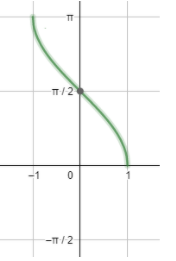
The equation $2{{\cos }^{-1}}x+{{\sin }^{-1}}x=\dfrac{11\pi }{6}$ .
(a) No solution.
(b) Only one solution
(c) Two solutions
(d) Three solutions
Answer
220.2k+ views
Hint: Start by using the identity ${{\cos }^{-1}}x+{{\sin }^{-1}}x=\dfrac{\pi }{2}$ and rearrange the equation to get an equation of the form ${{\cos }^{-1}}x=k$ , where k is constant. Now if k lies in the range of ${{\cos }^{-1}}x$ then the equation may have solutions else the equation will never have a solution.
Complete step-by-step answer:
Before starting with the solution to the above question, we will first talk about the required details of different inverse trigonometric ratios. So, we must remember that inverse trigonometric ratios are completely different from trigonometric ratios and have many constraints related to their range and domain.
Now let us draw the graph of $co{{s}^{-1}}x$ .

So, looking at the above graphs, we can draw the conclusion that ${{\cos }^{-1}}x$ is defined for all real values of $x\in [-1,1]$ , while its range comes out to be $\left[ 0,\pi \right]$ . The domain of ${{\sin }^{-1}}x$ is same as that of ${{\cos }^{-1}}x$ but its range is $\left[ -\dfrac{\pi }{2},\dfrac{\pi }{2} \right]$ .
Now moving to the solution to the above question, we will start with the simplification of the expression given in the question.
$2{{\cos }^{-1}}x+{{\sin }^{-1}}x=\dfrac{11\pi }{6}$
We know that ${{\cos }^{-1}}x+{{\sin }^{-1}}x=\dfrac{\pi }{2}$ for all x lying in the domain of ${{\cos }^{-1}}x$ and ${{\sin }^{-1}}x$ .
$co{{s}^{-1}}x+{{\cos }^{-1}}x+{{\sin }^{-1}}x=\dfrac{11\pi }{6}$
$\Rightarrow co{{s}^{-1}}x+\dfrac{\pi }{2}=\dfrac{11\pi }{6}$
$\Rightarrow co{{s}^{-1}}x=\dfrac{11\pi }{6}-\dfrac{\pi }{2}$
$\Rightarrow co{{s}^{-1}}x=\dfrac{11\pi -3\pi }{6}=\dfrac{8\pi }{6}=\dfrac{4\pi }{3}$
Now as $\dfrac{4\pi }{3}$ is greater than $\pi $ , we can say that the equation can never be true as $co{{s}^{-1}}x$ can never be greater than $\pi $ , So, the equation has no solution.
Therefore, the answer to the above question is option (a).
Note: Students generally get confused in the range of different inverse trigonometric functions as they very much look the same but are far different. Also, it is important that you check the domain of each inverse trigonometric term in the equation separately before reporting a value of x that satisfies the equation.
Complete step-by-step answer:
Before starting with the solution to the above question, we will first talk about the required details of different inverse trigonometric ratios. So, we must remember that inverse trigonometric ratios are completely different from trigonometric ratios and have many constraints related to their range and domain.
Now let us draw the graph of $co{{s}^{-1}}x$ .

So, looking at the above graphs, we can draw the conclusion that ${{\cos }^{-1}}x$ is defined for all real values of $x\in [-1,1]$ , while its range comes out to be $\left[ 0,\pi \right]$ . The domain of ${{\sin }^{-1}}x$ is same as that of ${{\cos }^{-1}}x$ but its range is $\left[ -\dfrac{\pi }{2},\dfrac{\pi }{2} \right]$ .
Now moving to the solution to the above question, we will start with the simplification of the expression given in the question.
$2{{\cos }^{-1}}x+{{\sin }^{-1}}x=\dfrac{11\pi }{6}$
We know that ${{\cos }^{-1}}x+{{\sin }^{-1}}x=\dfrac{\pi }{2}$ for all x lying in the domain of ${{\cos }^{-1}}x$ and ${{\sin }^{-1}}x$ .
$co{{s}^{-1}}x+{{\cos }^{-1}}x+{{\sin }^{-1}}x=\dfrac{11\pi }{6}$
$\Rightarrow co{{s}^{-1}}x+\dfrac{\pi }{2}=\dfrac{11\pi }{6}$
$\Rightarrow co{{s}^{-1}}x=\dfrac{11\pi }{6}-\dfrac{\pi }{2}$
$\Rightarrow co{{s}^{-1}}x=\dfrac{11\pi -3\pi }{6}=\dfrac{8\pi }{6}=\dfrac{4\pi }{3}$
Now as $\dfrac{4\pi }{3}$ is greater than $\pi $ , we can say that the equation can never be true as $co{{s}^{-1}}x$ can never be greater than $\pi $ , So, the equation has no solution.
Therefore, the answer to the above question is option (a).
Note: Students generally get confused in the range of different inverse trigonometric functions as they very much look the same but are far different. Also, it is important that you check the domain of each inverse trigonometric term in the equation separately before reporting a value of x that satisfies the equation.
Recently Updated Pages
Mutually Exclusive vs Independent Events: Key Differences Explained

Area vs Volume: Key Differences Explained for Students

Geometry of Complex Numbers Explained

Electricity and Magnetism Explained: Key Concepts & Applications

JEE Energetics Important Concepts and Tips for Exam Preparation

JEE Isolation, Preparation and Properties of Non-metals Important Concepts and Tips for Exam Preparation

Trending doubts
JEE Main 2026: Application Form Open, Exam Dates, Syllabus, Eligibility & Question Papers

Derivation of Equation of Trajectory Explained for Students

Hybridisation in Chemistry – Concept, Types & Applications

Understanding the Angle of Deviation in a Prism

How to Convert a Galvanometer into an Ammeter or Voltmeter

JEE Main Marking Scheme 2026- Paper-Wise Marks Distribution and Negative Marking Details

Other Pages
JEE Advanced Marks vs Ranks 2025: Understanding Category-wise Qualifying Marks and Previous Year Cut-offs

Degree of Dissociation: Meaning, Formula, Calculation & Uses

Ideal and Non-Ideal Solutions Explained for Class 12 Chemistry

Understanding the Electric Field of a Uniformly Charged Ring

Understanding Electromagnetic Waves and Their Importance

Understanding Collisions: Types and Examples for Students




